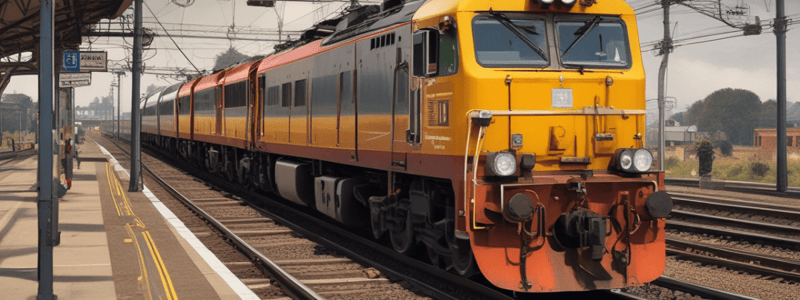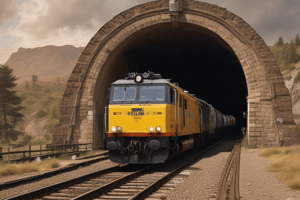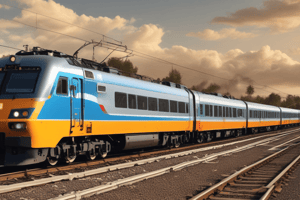Podcast
Questions and Answers
What should be removed in time to avoid short-circuiting?
What should be removed in time to avoid short-circuiting?
- Metal burrs at the end (correct)
- Sleepers in the vicinity of the joints
- Rail ends with brake dust
- Fish bolts at the insulated joints
Why should ballast be clean in the vicinity of glued insulated joints?
Why should ballast be clean in the vicinity of glued insulated joints?
- To increase the lifespan of the rails
- To reduce the risk of short-circuiting
- To prevent rail ends from corrosion
- To ensure efficient packing and drainage (correct)
What happens in case of failure of glued joints?
What happens in case of failure of glued joints?
- The rail ends get corroded
- The sleepers get damaged
- The fishplates crack or break (correct)
- The rails get shortened
What should be kept free from brake dust, dirt, sand, rust, etc.?
What should be kept free from brake dust, dirt, sand, rust, etc.?
How should PSC Sleepers be laid and maintained?
How should PSC Sleepers be laid and maintained?
What is recommended while carrying out track renewals with concrete sleepers?
What is recommended while carrying out track renewals with concrete sleepers?
What should be kept clean with efficient drainage?
What should be kept clean with efficient drainage?
What is the purpose of heaping up of ballast in the tamping zone?
What is the purpose of heaping up of ballast in the tamping zone?
What is the purpose of refurbishing a glued joint?
What is the purpose of refurbishing a glued joint?
What is done to hogged joints before tamping?
What is done to hogged joints before tamping?
What is done to broken and damaged sleepers?
What is done to broken and damaged sleepers?
Why are obstructions such as signal rods, cables, pipes, level crossing check rails, etc., removed?
Why are obstructions such as signal rods, cables, pipes, level crossing check rails, etc., removed?
What should be marked on every second/third sleeper?
What should be marked on every second/third sleeper?
What should be the tamping depth during tamping?
What should be the tamping depth during tamping?
Why is it important to ensure that tamping tools are inserted centrally between the sleepers?
Why is it important to ensure that tamping tools are inserted centrally between the sleepers?
Who should be informed about the beginning and end of transitions?
Who should be informed about the beginning and end of transitions?
What is the recommended minimum depth of clean ballast cushion below the bottom of sleepers for proper functioning of tie tampers?
What is the recommended minimum depth of clean ballast cushion below the bottom of sleepers for proper functioning of tie tampers?
What is the purpose of deep screening of ballast?
What is the purpose of deep screening of ballast?
Who is responsible for providing adequate time for economical working of tamping machines?
Who is responsible for providing adequate time for economical working of tamping machines?
What is the purpose of pre-tamping attention?
What is the purpose of pre-tamping attention?
What should be done before taking up the tamping?
What should be done before taking up the tamping?
What should be followed during packing in LWR/CWR track?
What should be followed during packing in LWR/CWR track?
Why should small track machines be deployed?
Why should small track machines be deployed?
What should be done to ensure that adequate time is available for economical working of tamping machines?
What should be done to ensure that adequate time is available for economical working of tamping machines?
What should be done to plan the deployment of tamping machines for plain track and Points & Crossings?
What should be done to plan the deployment of tamping machines for plain track and Points & Crossings?
What should the Gang Mate and Track Maintainers do during the passage of trains?
What should the Gang Mate and Track Maintainers do during the passage of trains?
Why is firm and uniform packing necessary?
Why is firm and uniform packing necessary?
What is the purpose of systematic tamping of plain track and Points & Crossings?
What is the purpose of systematic tamping of plain track and Points & Crossings?
What is the purpose of systematic overhauling?
What is the purpose of systematic overhauling?
What should be shifted to shoulders for screening by the machine?
What should be shifted to shoulders for screening by the machine?
How often should loop lines be shallow screened/overhauled?
How often should loop lines be shallow screened/overhauled?
What is the first operation in the sequence of overhauling?
What is the first operation in the sequence of overhauling?
What is the ratio of sleepers in the turnout portion for a 1 in 8½ turnout?
What is the ratio of sleepers in the turnout portion for a 1 in 8½ turnout?
How should the sleepers in the crossing portion be placed?
How should the sleepers in the crossing portion be placed?
What is the purpose of the approach sleepers in advance of the switch portion?
What is the purpose of the approach sleepers in advance of the switch portion?
How should the complete assembled turnout be inserted in position?
How should the complete assembled turnout be inserted in position?
What should be done to ensure the alignment and level of the sleepers during manual insertion?
What should be done to ensure the alignment and level of the sleepers during manual insertion?
What should be provided behind the crossing portion to introduce rail slope?
What should be provided behind the crossing portion to introduce rail slope?
What is the recommended way to provide motor housing in the switch portion?
What is the recommended way to provide motor housing in the switch portion?
What is the recommended way to break down the complete assembled turnout for insertion?
What is the recommended way to break down the complete assembled turnout for insertion?
Flashcards are hidden until you start studying
Study Notes
Maintenance of Rail Joints
- Metal burrs at the end of rail joints should be removed in time to avoid short-circuiting.
- Fish bolts at insulated joints must be kept tight, and sleepers packed well in the vicinity of joints.
- Rail ends should be kept free from brake dust, dirt, sand, rust, and other foreign materials.
Maintenance of Glued Insulated Joints
- Ballast used in track in the vicinity of glued insulated joints should be clean to ensure efficient packing and drainage.
- Care should be taken to ensure that the ballast is clear of rails and rail fastenings.
- In glued joints, no relative movement occurs between rails and fishplates; if failure occurs, the damaged joint shall be refurbished/replaced.
Laying of PSC Plain Track Sleepers
- PSC Sleepers shall be laid and maintained square to the rails on straights and radially on curves, and rail joints should be suspended.
- Relaying with Mechanical Equipment should be adopted while carrying out track renewals with concrete sleepers.
- The preliminary work prior to relaying at site, the actual relaying process, and the post-relaying operations are described in detail in “IRTMM”.
Systematic Tamping of Plain Track and Points & Crossings
- Systematic tamping of plain track and Points & Crossings should be planned on long continuous lengths based on results of TRC/OMS.
- Deployment of Tamping Machines should be based on results of TRC/OMS, past history of deterioration of track, traffic GMT, type of formation, condition of track and its components.
Pre-requisites to Introduction of Mechanical Maintenance
- A minimum depth of 150 mm of clean ballast cushion below the bottom of the sleepers is recommended for the proper functioning of the tie tampers.
- Adequate ballast should be available in the shoulders and cribs.
- Time allowance for working the machines should be provided in the working timetable.
- It is the responsibility of both the Operating Department and the Engineering Department to ensure provision of adequate time for economical working of machines.
Pre-tamping Attention
- Ballasting where there is a shortage of ballast.
- Heaping up of ballast in the tamping zone to ensure effective packing.
- Making up of low cess.
- Cleaning of pumping joints and providing additional clean ballast, where necessary.
- Attention to hogged joints before tamping.
- Tightening of all fittings and fastenings like fish bolts and elastic fastenings and replacement of worn-out fittings.
- Renewing broken and damaged sleepers.
- Squaring of sleepers and spacing adjustment; re-gauging to be done as necessary.
- Adjusting creep and expansion gap in rails.
- Examination of rails for cracks, sleepers, and fastenings, etc.
- Survey for Realignment of curves, which are badly out of alignment.
- Clearing of ballast on sleepers to make them visible to the operator.
- All obstructions such as signal rods, cables, pipes, level crossing check rails, joggled fish plates, etc., likely to be damaged by the tampers should be preferably removed.
Observance of Sleepers under Passage of Traffic
- Gang Mate and Track Maintainers should stand on the cess each about one rail-length apart on either side of the portion of track they are attending to, and observe the movement of sleepers under load.
- Immediately after the passing of the train, loose sleepers should be marked, packed uniformly, and the packing tested.
Systematic Overhauling
- The length of the section to be overhauled shall be such that complete overhauling of track will be accomplished within a specific period (normally 3 to 5 years).
- Overhauling should be done using SBCM for cleaning of shoulder ballast.
- The crib ballast should also be shifted to shoulders for screening by the machine, which should again be put back in crib portion.
Studying That Suits You
Use AI to generate personalized quizzes and flashcards to suit your learning preferences.




